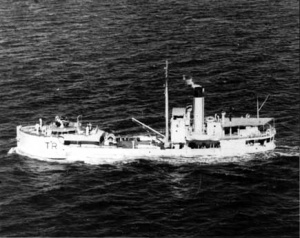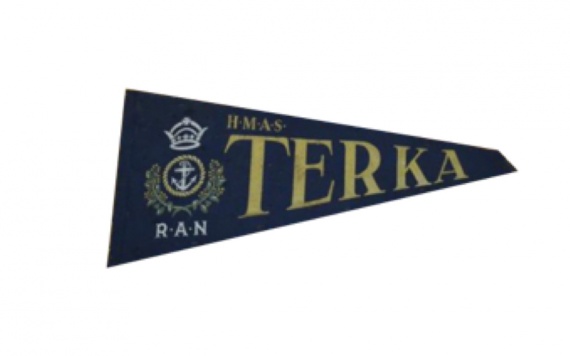HMAS Terka
| Type |
Auxiliary Minesweeper |
|---|---|
| Pennant |
TR |
| Builder |
State Dockyard, Newcastle, NSW |
| Commissioned |
31 January 1941 |
| Decommissioned |
25 January 1943 |
| Fate |
Unexpectedly sunk alongside Madang 26 March 1944 |
| Dimensions & Displacement | |
| Displacement | 420 tons |
| Length | 147 feet |
| Beam | 26 feet 7 inches |
| Draught | 9 feet 2 inches |
| Performance | |
| Speed |
|
| Complement | |
| Crew | 4 officers and up to 24 sailors |
| Propulsion | |
| Machinery | Triple expansion steam engine, single screw |
| Armament | |
| Guns |
|
| Awards | |
| Battle Honours | DARWIN 1942-43 |
The coastal steamer Sir Dudley de Chair was built for Dorman, Long & Co in 1925. In 1928 she was acquired by the Adelaide Steamship Co Ltd and renamed Terka. On 7 October 1940, the Royal Australian Navy (RAN) requisitioned her for war service.
HMAS Terka commissioned at Sydney on 31 January 1941 under the command of Lieutenant Donald K Cracknell, RANR(S). Although taken up for service as an auxiliary minesweeper, Terka was also employed as a general purpose vessel.
On 27 March 1941, Terka sailed from Sydney to conduct a search for mines off the New South Wales coast. This followed the sinking of the trawler Millimumul which had struck a German mine while fishing the previous day. On 20 April, Terka departed Sydney for Darwin in company with another auxiliary minesweeper HMAS Tolga.
En route to Darwin the two ships called at Brisbane where Tolga took in tow a store lighter before proceeding with Terka to Cairns. Here, Terka took the coal lighter Apa in tow for the passage to Darwin where the four vessels arrived on 4 June 1941. Terka and Tolga were then employed conducting continuous sweeps in the Darwin area.
Terka and Tolga were at Darwin on 19 February 1942 during the first Japanese air raid. At the time they were being used to provide water to a large concentration of ships lying at anchor. The port had become congested due to poor working conditions ashore and inadequate wharf facilities which allowed only two ships to unload their cargo simultaneously. This hindrance was further aggravated by a cyclone which had struck Darwin earlier in the month, closing the port for six days. The ships at anchor were unable to connect to shore services and were reliant upon, Terka and Tolga for all their fresh water requirements. As both vessels were capable of carrying up to 200 tons of water, they were ideally suited to this task.
Following the initial Japanese strike, Terka and Tolga were active in rendering assistance to those vessels which had been hit. Terka was lucky to escape damage and casualties and spent the day rescuing crewmen from the burning troopship Zealandia which had been struck by a bomb that smashed through her number three hatch and exploded in her hold.
In mid-1942 Terka assumed duty as a stores and troop carrier, running mainly to points on the north-west Australian coast. She also continued to act as a general purpose vessel in Darwin Harbour until 17 December, when she relieved Tolga at Thursday Island as a water carrier.
On 25 January 1943, Terka returned to Darwin where she resumed carrying general stores and personnel to outlying Army and Air Force posts. In July 1943 she provided additional fuel and water to a pair of Fairmile motor launches, ML 814 and ML 815, in St Asaphs Bay, Melville Island, in preparation for Operation MOSQUITO, a clandestine operation to Timor. In September she sailed to Cairns for refitting.
In January 1944, Terka transferred to the New Guinea area. At 10:07 pm on 26 March 1944, she was alongside the coal hulk Rona* in Madang Harbour, having recently completed coaling, when without warning she took on a sudden list to starboard before coming to an even keel and sinking stern first in eleven fathoms. The weather was dead calm and there was no immediate explanation for her loss. There were only two minor casualties, both of whom recovered from their ordeal in hospital.
During 1971, RAN Clearance Diving Team One partly cleared the wreck which was obstructing a channel needed to allow oil tankers access to storage tanks to discharge their cargoes.
* Rona was formerly the three masted iron barque Polly Woodside. She has now been restored under her original name and is a floating maritime museum in Melbourne.




